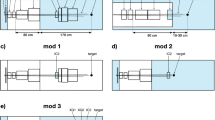Abstract
In this paper we report on the main design features, on the realization process and on selected first results of the initial commissioning of the new Gantry 2 of PSI for the delivery of proton therapy with new advanced pencil beam scanning techniques. We present briefly the characteristics of the new gantry system with main emphasis on the beam optics, on the characterization of the pencil beam used for scanning and on the performance of the scanning system. The idea is to give an overview of the major components of the whole system. The main long-term technical goal of the new equipment of Gantry 2 is to expand the use of pencil beam scanning to the whole spectrum of clinical indications including moving targets. We report here on the initial experience and problems encountered in the development of the system with selected preliminary results of the ongoing commissioning of Gantry 2.
Similar content being viewed by others
References
M. Phillips et al., Phys. Med. Biol. 37, 223 (1992).
C.V. Essen et al., Int. J. Radiat. Oncol. Biol. Phys. 8, 1499 (1982).
E. Hug, PSI Scientific Report 2009: http://www.psi.ch/info/MediaBoard/PSI_ScientificReport_2009.pdf
E. Pedroni et al., Med. Phys. 22, 37 (1994).
T. Haberer et al., Nucl. Instrum. Methods A 330, 296 (1993).
A.J. Lomax et al., Phys. Med. Biol. 44, 185 (1999).
E. Pedroni, in Treatment Planning for External Beam Therapy with Neutrons, edited by G. Burger, J.J. Broerse (Urban & Schwarzenberg, Munich, 1981) pp. 60-69
E. Pedroni, Radiat. Environm. Biophys. 16, 211 (1979).
E. Pedroni, in Proton and Charged Particle Radiotherapy, edited by T.F. DeLaney, H.M. Kooy (Williams and Wilkins, Boston, MA, 2008) chapt. 5b
J.M. Schippers, Rev. Acc. Science and Technology 2, 179 (2009).
E. Pedroni et al., Z. Med. Phys. 14, 25 (2004).
A. Gabard et al., IEEE Trans. Appl. Supercond. 20, 794 (2010).
K.L. Brown, yellow reports CERN 73-16 (1973) & CERN 80-04 (1980).
E. Pedroni et al., Phys. Med. Biol. 50, 541 (2005).
Calculation using the Graphic TRANSPORT Framework of U. Rohrer at PSI: http://aea.web.psi.ch/Urs_Rohrer/MyWeb/trans.htm
S. Kowalski, H.A. Enge, RAYTRACE, MIT, Cambridge MA USA, 1987
E. Pedroni, H. Enge, Med. & Biol. Eng. & Comput. 33, 271 (1995).
D.C. Carey, K.L. Brown, F. Rothacker, Fermilab-Pub-95/0: http://lss.fnal.gov/archive/1998/pub/Pub-98-310.pdf
J.F. Ziegler, SRIM and TRIM, http://www.srim.org/
S.N. Boon et al., Med. Phys. 27, 2198 (2000).
S.M. Zenklusen, E. Pedroni, D. Meer, Phys. Med. Biol. 50, 5103 (2010).
S.M. Zenklusen, to be published in Med. Phys. in 2011
Author information
Authors and Affiliations
Corresponding author
Rights and permissions
About this article
Cite this article
Pedroni, E., Meer, D., Bula, C. et al. Pencil beam characteristics of the next-generation proton scanning gantry of PSI: design issues and initial commissioning results. Eur. Phys. J. Plus 126, 66 (2011). https://doi.org/10.1140/epjp/i2011-11066-0
Received:
Accepted:
Published:
DOI: https://doi.org/10.1140/epjp/i2011-11066-0




